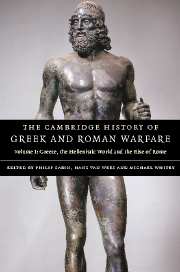Book contents
- Frontmatter
- Introduction: The Historiography of Ancient Warfare
- Part I Archaic and Classical Greece
- Part II The Hellenistic World and the Roman Republic
- 10 International relations
- 11 Military forces
- 12 War
- 13 Battle
- 14 Warfare and the state
- 15 War and society
- Chronological Table
- Glossary
- List of Ancient Authors
- Bibliography
- Index of ancient passages cited
- General index
- Map 1 The western Mediterranean
- Map 3 The Near East
- References
13 - Battle
from Part II - The Hellenistic World and the Roman Republic
Published online by Cambridge University Press: 28 March 2008
- Frontmatter
- Introduction: The Historiography of Ancient Warfare
- Part I Archaic and Classical Greece
- Part II The Hellenistic World and the Roman Republic
- 10 International relations
- 11 Military forces
- 12 War
- 13 Battle
- 14 Warfare and the state
- 15 War and society
- Chronological Table
- Glossary
- List of Ancient Authors
- Bibliography
- Index of ancient passages cited
- General index
- Map 1 The western Mediterranean
- Map 3 The Near East
- References
Summary
introduction
The great land battles of the Hellenistic and mid-Republican era are perhaps the most striking single aspect of warfare at that time. In the largest, 100,000 or more troops clashed in climactic contests which in just a few hours transformed one army from a fearsome military force into a shattered mixture of corpses, captives and panic-stricken fugitives. These battles might not in themselves be ‘decisive’ if the losing side had both the resources and the commitment to raise further forces to continue the fight. However, they did profoundly affect the course of conflicts, and spelt doom for any antagonist without the means to recover from defeat.
Historians both ancient and modern have felt the dramatic power of these set-piece contests, and have accorded them special attention in their works. In the ancient world, the ‘battle piece’ was a staple ingredient of historical writing, and incorporated various more or less formulaic elements – a description of the composition and deployment of the opposing armies, a recitation of (impossibly long and high-flown) speeches by the opposing generals, a comparatively brief account of the fighting itself, focusing on anecdotal aspects such as the heroic conduct or death of a commander or the contribution of ‘exotic’ weapons like elephants or chariots, and finally a tailpiece detailing the respective losses and the aftermath of the engagement.
Keywords
- Type
- Chapter
- Information
- The Cambridge History of Greek and Roman Warfare , pp. 399 - 460Publisher: Cambridge University PressPrint publication year: 2007
References
- 5
- Cited by

